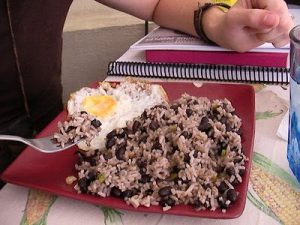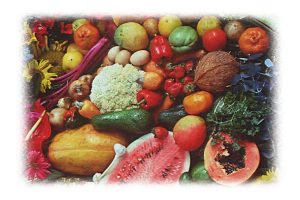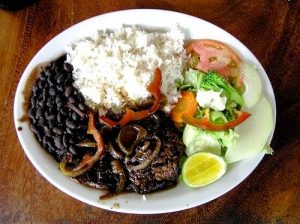To generalize a Costa Rican meal, one would certainly have to talk about black beans and rice (gallo pinto). This simple, standard dish, often referred to as comida tipica, is the backbone of Costa Rican cuisine. While many of the dishes are still prepared with oils high in saturated fats, Costa Rican food is generally quite healthy when coupled with an active lifestyle. Cheese and other dairy products are rarely utilized.
Cheese can contribute to a high amount of fat and cholesterol to your diet, especially cheddar cheese.
Often served with a good portion of fruits or vegetables or both, the  meals are very well rounded and generally high in fiber.
meals are very well rounded and generally high in fiber.
Other factors in the Tico’s healthy mealtime experience are their eating habits. Firstly, Ticos do not eat in excess. Their modest proportions are much like the Europeans and smaller than that of the U.S. Secondly, Ticos make lunch the main meal of the day. In fact, many employers will give an additional hour off for a post-lunch casado. This convention will provide more energy during the day when people need it, and less energy at night when it will likely be wasted and converted to fat reserves.
San José possesses a broad spectrum of fare. On one hand, it is the center of fine dining and international cuisine in Costa Rica; on the other, its streets and markets are filled with sodas, or small restaurants that serve light meals and snacks. Away from the big city, Ticos are less adventurous eaters, so the food becomes more grounded in peasant culture and less varied.
Staples
As mentioned above, beans and rice is the basic variable in almost all Costa Rican cuisine. A typical meal is the casado, the name referring to the eternal “marriage” of its components. Consisting of rice and beans, meat or fish, fried plantains, and a carrot, tomato, and cabbage salad, this basic and well-rounded meal strikes a good nutritional balance.
The plantain, or plántano, is probably the quintenencial Tico snack. It has the appearance of a large banana, but cannot be eaten raw. It is sweet and delicious when fried or baked, and will often accompany most meals. When sliced thinly and deep fried, the plantain becomes a crunchy snack like the potato chip.
Arroz is a dish of fried rice which may be offered with chicken (pollo) or shrimp (gambas). For breakfast, it is common to be served a hearty dish of black beans and rice (gallo pinto) seasoned with onions and peppers, accompanied by fried eggs, sour cream, and corn tortillas.
Soups and Stews
Olla de carne is a delicious stew made with beef, potatoes, carrots, chayote (vegetable pear), plantains and yucca. Sopa negra is a simple soup made with black beans. The hearty Sopa de mondongo is made with tripe and vegetables. Guiso de maíz is a corn stew.
Vegetables and Fruit
Vegetables are utilized mostly in soups and stews, or, as a side dish of a casado meal, fresh cabbage, tomatoes, and carrots make up the typical salad. Corn is one of the most favored vegetables, and it is usually prepared in the form of tortillas and corn pancakes. Corn on the cob is sometimes roasted, elote esado, or boiled, elote cocinado. Empanadas are corn turnovers filled with beans, cheese, and maybe potatoes and meat. And Patacones are fried mashed plantains with a liberal sprinkling of salt.
Fruits found in Costa Rica include papaya, mango, piña (pineapple), sandía (watermelon), melón (cantaloupe), moras (blackberries), limones (lemons), guayaba (guava), granadilla (passion fruit), and aguacates (avocados). Many of these are served plain or as a refresco, a blended drink with ice.
 Marañon is a curious fruit whose seed is the cashew. The skin of the fruit is bitter, but the flesh delicious. Cashews must be roasted before they are consumed; a raw cashew is poisonous.
Marañon is a curious fruit whose seed is the cashew. The skin of the fruit is bitter, but the flesh delicious. Cashews must be roasted before they are consumed; a raw cashew is poisonous.
Zapotes are a brown fruit resembling an oversized avocado in appearance and texture. Unlike the avocado their pulp is very sweet and bright red-orange in color.
Guanábanas (soursop) are textured, green football-sized fruits with white fibrous flesh. Some eat the fruit plain, but most prefer it as a juice or with milk.
Pipas (green coconuts) are extremely popular among Ticos. By chopping the top with a machete and tapping the hollow core with a straw, you have a refreshing drink.
The pejibaye, a relative of the coconut, is a bizarre fruit. It’s flesh is thick and fibrous, and resembles the taste of chestnut or pumpkin. They are usually boiled in salt water, peeled, halved, pitted, then eaten.
The manzana de agua is a dark red, pear-shaped fruit that is full of juice and quite refreshing.
The palmito (palm heart) is the inner core of a small palm tree and makes a great delicacy as a cocktail.
Carambola (starfruit) is a yellow-green tender fruit that when cut across makes slices that look like five-pointed stars. The taste is lightly sweet and juicy.
Meats and Fish
Roast pork is the chief meat staple. Pork and chicken are often roasted over coffee wood for a savory, smokey flavor. Steaks can be found at many restaurants, and chewy is desirable. Ultra-fresh seafood is more readily available near the coasts, though shrimp and lobster are offered throughout most of the country. San José’s fish of choice is sea bass, or corvina; however, dorado, swordfish, and myriad others are available at the coastal resorts. As a common appetizer, Ceviche is a dish of raw fish marinated in lemon juice with cilantro and onions.
Common Dishes and Condiments
Tortilla – name for either a small, thin corn tortilla, or an omellete
Tortilla de queso – a thick tortilla with cheese in the dough
Arreglados – greasy puff pastries made with meat
Tortas – sandwiches on buns
Arroz con polo – rice with chicken and vegetables
Gallos – meat, beans, or cheese between two tortillas
Masamorra – corn pudding
Natilla – sour cream of a relatively thin consistency
Palomitas de maíz – popcorn
Picadillo – sautéed vegetables sometimes with meat, served as a side dish
Tacos – meat and cabbage salad tucked into a tortilla
Tamal de elote – sweet corn tamales wrapped in corn husks
Tamales – cornmeal, often stuffed with pork or chicken, wrapped in banana leaves and boiled
Deserts and Sweets
Cajeta de coco – a fudge made of coconut, tapa dulce, and orange peel Cono capuchino – an ice cream cone dipped in chocolate
Melcochas – candies made from raw sugar
Milanes and tapitas – small, delicious, pure-chocolate candies
Tapa dulce – brown sugar, native to Costa Rica, sold in a solid form
Dulce de leche – a thick syrup made of sugar and milk
Tres leches – a three-layered custard flan, and the national desert
Breads and Baked Goods
Pan bon – a dark, sweet bread of Limon.
Pan de maíz – a thick, sweet bread made with corn.
Queque seco – pound cake
Tamal asado – sweet cornmeal cake
Torta chilena – a multi-layered pastry filled with dulce de leche
Drinks
Beer is also a common drinkamong Ticos. Two local breweries, Bavaria and Imperial, make light and crisp lager-style beers, perfect thirst-quencher for the balmy, tropical climate.
Wine is not very popular and is usually imported and expensive. The working man’s drink is guaro, a clear white spirit that doesn’t always appeal to visitors.
Coffee is also an extremely popular and nationally-revered drink.
Caribbean Flavors
The Caribbean coast has its own unique cuisine, distinctive of the rest of the nation. The dishes usually include coconut milk and more characteristic spices, like ginger and curry. Roadside stalls sell a vast array of fruits: apples, papayas, mangoes, bananas, pineapples, apricots, and melons. Coconuts are widely used in the Caribbean. Grated coconut is used in many deserts and cakes. Coconut milk is a staple used to bind other ingredients in recipes. Milk is used in cheeses, such as the soft white queso blanco, which frequently finds its way into deserts. The akee is a spongy yellow fruit native to Africa and brought to the Caribbean by the English. It is boiled to produce something that resembles scrambled eggs, then sautéed with salted cod. The patí is a spicy meat pie resembling a turnover. Rondon (“rundown”) consists of fish or meat with yams, plantains, breadfruit, peppers and spices.
From Viva Costa Rica



Comments are closed.